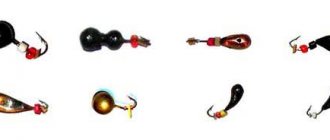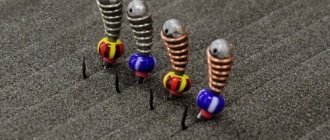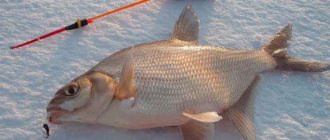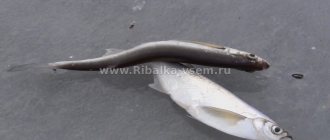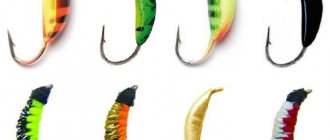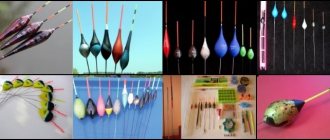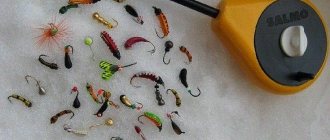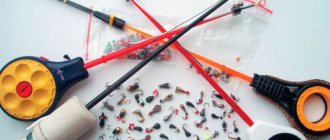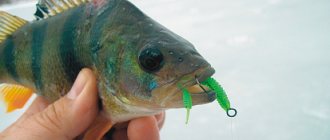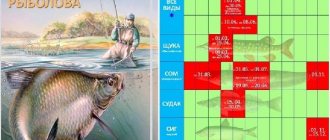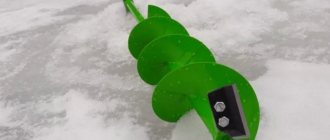in the photo Maxim Efimov is the world champion in winter fishing
Hello!
My name is Maxim Efimov . The first ice is just around the corner. I would like to share a little of my experience in the field of jigs. I am the world champion in this sports discipline. I’ll tell you about the features of jigs and what they are like, how to choose a jig and some subtleties.
Let's look at jigs that are most suitable for the mass consumer. Those that can actually be bought at a fishing store, i.e. come, buy, collect gear and go fishing.
For example, I took jigs from the Spider brand. These jigs are made of tungsten. Some of them are galvanized, some are painted. Each has its own advantages. I would like to dwell on this in more detail.
Spider jigs.
Jigs in the online store Rybolov.ORG
Varieties of jigs
Jigs are divided into many groups and types according to different characteristics; it is simply impossible to tell about each one. The bait is constantly being improved, new types appear, and details are added to existing ones. For a novice angler, it’s quite easy to get lost in the variety, so let’s try to divide jigs into several main types.
Winter
The most common are winter jigs; with their help you can catch even inactive fish. They are distinguished by their small size, but their shape and color can be very different. To attract the attention of the inhabitants of the reservoir, they often additionally put artificial or live bait on them.
Winter jigs can be roughly divided into:
- perch is usually caught using a product from 2 mm to 6 mm in size, most often a bloodworm is placed on the hook;
- a large version of an oblong shape is perfect for catching pike perch; this predator is attracted by its white color;
- The clamp jig has a small hook and is designed for a small catch; baiting bloodworms will be problematic, so there is a kind of clothespin located near the hook;
- baitless species are distinguished by a large number of cambrics and beads used, which attract fish.
The weight of all these species varies greatly, it all depends on the reservoir, its depths, inhabitants, water transparency, and bottom topography.
Summer jigs
It is quite easy to distinguish the winter type from the summer one, although in most cases the shape will be identical. So, the summer version has the following characteristics:
- the size of summer jigs is much larger than winter jigs;
- color preference remains with copper or brown, other colors will be less popular;
- A ball or drop is most suitable for fishing in the summer.
Victoria Leshchenko
I've been working hard in the fishing tackle department for the past six years. I can help you assemble almost any gear.
Ask a Question
For individual bodies of water, other shapes and colors are sometimes used; the selection of jigs often requires an individual approach.
For fishing with bait
For fishing from ice with bait in the form of bloodworms or worms, jigs of various shapes are used, and in addition there will be no multi-colored cambrics or beads on the hook.
Often jigs have a fairly large hook, this allows you to attach a bunch of bloodworms or use a small worm without cutting it.
The color is selected individually, but the best fishing is for black-colored products.
Nozzleless
Fishing without the use of baits of animal origin makes its own adjustments to the appearance of the product. To attract the attention of residents of the reservoir, who are not particularly active in winter, jigs are equipped with multi-colored accessories of artificial origin. Most often used:
- beads;
- sequins;
- cambrics.
Some have brass balls or cubes; this innovation has recently come to us.
Nozzle jigs can have one, two or three hooks, depending on this their name changes:
- a nozzle jig with a double hook is called a goat;
- a triple fixed hook is characteristic of the devil;
- The so-called witch has three hooks located on opposite sides of the body of the jig and moving freely.
Single-hook baits have many names, in most cases it comes from the shape of the body of the jig or from additional accessories.
These are the main types, but there are many more different products.
Fishing options
When choosing a jig, you need to decide in advance for which of the two fishing methods it will be used: with bait or without bait. The choice of shape, color and material of the bait will depend on this.
Attachment jigs
The classic version of lures is a jig with a nozzle . They have a simple symmetrical shape: ball, oval and drop. They are not distinguished by their bright colors. There is no need for a lot of variety, since their task is to deliver bait to the bottom for a specific type of fish.
The baits can be live : bloodworms, maggots, earthworms. To lure predators, a piece of fish or a whole small fish is baited onto a hook. Artificial attachments are also used : beads, beads, cambrics, colored wire and thread. Very effective are artificial maggots and bloodworms, which are dipped in a special liquid to acquire the appropriate smell. The advantage of these jigs is that there is no need to play with the bait. Therefore, this fishing method is suitable for beginners.
Mothless
Rewindless jigs are called rewindless, that is, nozzle-free jigs . They “work” without bait. This is a huge plus in winter fishing conditions, when bloodworm larvae can become covered in ice. In this regard, the shape, color, and especially the action of the bait become important. It should resemble one of the local representatives of the underwater world, which can attract the desired fish. There are many different mothless machines, so you need to choose the right model very carefully .
Jigs for predatory fish
Predators include large fish - perch, pike perch, pike, catfish. In accordance with this, baits should also be large and heavy . And if both lead and tungsten mini-spoons are suitable for perch, then for the rest it is better to take only tungsten ones of the largest possible sizes. The color of the bait does not play an important role, but calm tones are preferred - gray, black and brown. The classic drop shape has proven itself best. Bait from bloodworms, maggots or small fish is desirable, but not necessary.
Important! The game of the jig should resemble the movements of a fry, crustacean or other prey in the water, only in this case it will attract a predator better than any bait.
Gear selection
On store shelves there is a very large selection of jigs of different colors and shapes, and accordingly they will vary in weight. It often happens that a very small product has significant weight, and a large jig turns out to be lighter. What is the reason? Why does this happen?
This difference in size is explained by the material from which the tackle was made. The most common are lead and tungsten products, less common are silver and Wood's alloy.
Cargo material
The production of jigs occurs both at home and in factories. For this use:
- lead, their products are larger in size, but their specific gravity is much less. Ease of processing allows this material to be used for making products at home.
- Tungsten products, even with a small size, are quite heavy; processing such material at home is problematic. With this type of load, jigs are used in currents and great depths.
Victoria Leshchenko
I've been working hard in the fishing tackle department for the past six years. I can help you assemble almost any gear.
Ask a Question
Most often, experienced fishermen choose tungsten, but lead is also popular.
Form
Beginner fishermen, going to the store to buy tackle, believe that they can buy a couple of universal jigs, the shape of which will be attractive to all types of fish. But this is not at all true; the concept of a universal form simply does not exist.
When choosing a jig according to its shape, you should consider the following requirements:
- voluminous products will attract the attention of the inhabitants of the reservoir better;
- variants flattened at the top and bottom will raise a cloud of turbidity;
- a droplet and a ball create fountains of turbidity;
- a flat-shaped product plays especially well, creating a cloud of turbidity and simultaneously dispersing it, which especially attracts perch;
- uralka and ant work great with nodding movements;
- a jig with a cone-shaped body sinks slightly into the silt when lowered to the bottom;
- a ball, an oatmeal, a droplet will become saviors in the dead of winter;
- The devil is especially effective for catching perch, roach, bream and chub.
Many people believe that the ball and the droplet have a universal shape, but one can argue with this. Jigs in the form of a larva, ant, or fly are no less effective for various types of fish.
Weight
Regarding weight, everything is simple; heavier jigs are used at significant depths, medium and strong currents. General recommendations depend on the fishing location:
- products up to 0.25 g will be effective at depths of up to 2 meters, small fish will react;
- starting from 0.25 g and more, the product will attract the attention of a predator at depths of up to 4 m.
Large jigs are used by fishermen with experience in the first ice and before opening reservoirs, but the small size of the jigs will allow the game to be played more delicately.
Color
Color is also important; it is selected depending on weather conditions and the characteristics of the reservoir. To be sure of your catch, you should start from the following indicators:
- in sunny weather, darker colors of the product are used; on bright days, you can use a black jig all season long;
- depths of up to 6 m. It is worth fishing with copper products, it is to them that the inhabitant of the reservoir will respond best;
- silver and gold will work in cloudy weather, and the dark soil at the bottom of the reservoir will perfectly shade such a bait.
In reservoirs with depths of 10 meters, there is no need to change baits; absolutely any color will work.
Victoria Leshchenko
I've been working hard in the fishing tackle department for the past six years. I can help you assemble almost any gear.
Ask a Question
The more snow on the ice, the lighter the jig is tied; fishing on the first ice is always successful with dark colors, in particular black ones.
Hooks
The hook on the jig must correspond to the body; too large can scare away the fish, and a small one will not allow you to detect when biting. It is best to choose wire types; hardened ones will break when caught, which means you will have to re-tie the tackle. Steel wires will simply bend.
It is worth understanding that a real fisherman should have a variety of products in his arsenal. You can’t get hung up on one shape or color. To be successful, you need to constantly experiment.
Winter jigs
Such baits have an unusual shape, bright color and small dimensions (so as not to scare away the prey). Both attachment and nozzle models are used. To increase catchability, the design of the latter involves the presence of multi-colored beads, pieces of foam rubber or plastic. Of the 10 nominees reviewed by the Vyborexperta.Ru team, 4 best winter jigs were selected based on the greatest attractiveness for passive fish.
Ladoga
The model with a diameter of 0.4 cm is particularly popular and in demand among fishermen, since the shape of the ball is suitable for all types of reservoirs. It will help you catch both shallow ponds and fairly deep holes in winter fish stopover areas.
The heavy weight of the tungsten jig will make it easy to hold it in fast river currents. The red color with the addition of a light bead promotes effective mothless hunting. If desired, you can use bloodworms. Ladoga is suitable for catching perch, crucian carp, carp, pike perch and other peaceful and predatory animals.
Advantages:
- Excellent balancing;
- High-quality assembly;
- Affordable price;
- Suitable for micro jig fishing;
- Can be used in winter and summer.
Flaws:
- Not detected.
Due to its optimal size and shape, Ladoga is an ideal option for improving the skills of beginners.
Double witch
The unusual design of the bait contributes to high efficiency in catching predatory and peaceful fish of medium and large sizes. The body of the jig is equipped with a wire frame with 3 loops, which securely fixes 2 hooks.
To ensure unique play on leashes, the hooks are not soldered in, but flutter freely in the water. An additional provocative element for future mining here are beads of various shapes in bright colors.
The double witch is at its best at the beginning and end of winter. It is not advisable to use it in the middle of this season, since aggressive play scares away sleepy fish.
Advantages:
- Perfectly imitates a beetle;
- High quality;
- Sharp hook;
- Low price;
- Suitable for working in currents.
Flaws:
- Not suitable for catching small fish.
It is not recommended to use bait in reservoirs with small fish, as its large size will scare the living creatures.
Ant
...I was looking for cheap options for fishing gear for winter fishing. The ant showed excellent playing and diving qualities. The bait is highly catchable not only in winter, but also in spring, autumn and summer...
Expert opinion
Visually, one of the best jigs for winter is very similar to a real ant, which is an excellent treat for peaceful and predatory fish. The most effective bait of this type is on the first ice. Their combination with spinners or hooks is possible.
The ant is distinguished by high quality workmanship. Carefully machined edges of the hole eliminate the possibility of damage to the fishing line. Thanks to their increased diameter, it is possible to install a piece of thin cambric. This allows you to use fishing lines with the lowest density without losing strength at the knot.
Advantages:
- Suitable for bloodworm attachment;
- Flow stability;
- Low cost;
- Optimal ratio of diameter and weight (2.5 cm:0.34 g);
- A tempting reflection of the surface when hit by light.
Flaws:
- Lack of choice of colors.
Wolfram
The product from the Stolbik series is made of high-quality tungsten with a protective paint coating. This contributes to the high resistance of the structure to mechanical and corrosive effects.
The striking green color will be clearly visible from a great distance. A bright brass cube on the hook is an excellent addition for provoking predatory fish, which is especially important in conditions of low activity. A tungsten jig is suitable for fishing for brush, crucian carp, roach, soruce, as well as rudd, white bream, perch and bream.
Wolfram shows good catchability both in depth and in shallow water, even with low amplitude and frequency of nod oscillations. A sharpened single hook made in Japan and Norway significantly increases the chances of successful hooking.
Advantages:
- Reliable fastening of the hook to the body of the tackle;
- Durability;
- Optimal ratio of weight (0.8 g) and diameter (2.5 cm);
- Inexpensive;
- No special game rules are required for correct wiring.
Flaws:
- Not detected.
You can increase your fish catch by using an additional leash with a hook.
Jig fishing technique
Fishing with a jig is best done using a nod; this addition to the tackle will allow you to play the bait better.
The process is not complicated, but it must be carried out competently. It is best to observe more experienced comrades, but if this is not possible, then everything should be done in the following sequence:
- Drill several holes, alternately feed with bloodworms or winter bait.
- Starting from the hole into which the bait was placed first, fishing is carried out.
- The jig is lowered to the bottom, a nod will help with this.
- Next, tapping on the bottom is carried out for 5-10 seconds.
- Until the cloud of turbidity dissipates, the jig must be raised, and this must be done quickly enough.
- When lifting, you can additionally swing the rod slightly, this will attract the attention of more fish.
- Then they pause for 4-8 seconds and begin to lower the jig.
Such movements are considered the basis, then each fisherman makes his own additions and innovations, choosing the most convenient and successful method of play for himself.
DIY jig
As a rule, every fisherman immediately thinks about how to make a jig himself. By the way, most experienced fishermen do this, especially since there are no special difficulties, if only there was a desire and a minimum set of tools and accessories. As practice shows, homemade baits are in no way inferior in catchability to industrial designs. Some fishermen make them so well that they are superior in catchability to industrial models.
- First, you need to decide on the material for making the jig sample. It should be a material that can be easily processed with cutting tools. As a last resort, a blank made of dense wood, such as oak or ash, will do.
- In this fragment, for example, of wood, a spherical depression is made, which should be slightly smaller in size than the future jig. This operation can be performed using a figured chisel.
- During the work, care should be taken to ensure that the recess matches the shape of the future bait. To do this, you can use a set of shaped chisels, for example, for wood carving.
- As soon as the recess is ready, it should be carefully processed (cleaned with sandpaper), after which the entire surface is treated with dichloroethane.
- Then you need to take a strip of copper or brass and attach it to the mold. The thickness of the strip can be 0.25 mm or thinner. After this, take a suitable tool and make the same indentation on a metal strip. This must be done carefully so as not to damage the strip. To do this, all movements should be as soft as possible and without much effort.
- In the process of extruding on a metal strip, you should get the same depression as in a wooden blank.
- After such a recess is completely formed in the metal plate, the edges must be removed (trimmed), and the form itself must be processed and tinned with solder.
- In the center of the workpiece you need to make a hole with a diameter of 0.2 mm so that the wire can be pulled through it. You must then attach a hook to this wire.
- As soon as the hook is installed, the recess is filled with solder using a heated soldering iron.
- After the solder has completely hardened, the wire is removed. Finally, the jig lends itself to further processing: grinding and polishing. Alternatively, the jig can be painted any color or varnished.
In conclusion, we can say that the jig is a fairly effective tool in winter fishing conditions. And you don’t have to buy jigs and spend additional money on them. If you want, you can make dozens of them, of different shapes and different sizes. In addition, it can be painted in any color. Moreover, you can come up with a jig of any shape, which may turn out to be more catchy than any of those listed in this article.
How to bind
The outcome of a fishing trip often depends on how securely the jig is tied. It happened to many, even experienced fishermen, that the fish left along with the jig. Often the cause is incorrectly tied tackle.
To protect yourself from such troubles, you should learn how to knit a jig correctly. Tying methods mainly differ due to the type of jig; it is believed that products with a hole are more difficult to tie than a jig with an eye. You can securely bind in this way:
- first of all, they pass the fishing line through the hole in such a way that the length is enough for the knot;
- form a loop along the shank of the hook and press it with your finger;
- with the other hand make several turns of fishing line around the fore-end;
- the free end is pulled into the loop;
- holding the winding on the forend, get to the main one and tighten the knot.
To prevent the fishing line from slipping during fishing, it is advisable to burn the tip of the fishing line with a hot needle or a hot match.
Tandem fishing
To quickly fish different horizons of the water column, tandem equipment is used. Structurally, it looks like two jigs located at a distance of 20 to 35 cm from one another. The design makes the bait easier, unloading the weight on two attachments. An eyelet is used as the top one, which is tied in such a way that the hook remains in a horizontal position. The shape of the bottom bait is not important, but the “drop” predominates.
Tandem, like other catchable equipment, has disadvantages, the main one of which is lower quality play. Due to the windage formed by two baits, the frequency of oscillations is lost, and when fishing at a significant depth, it becomes more and more difficult to set it.
Self-production
Previously, purchasing a jig of the required shape and weight was problematic. Craftsmen made them themselves in several ways. Many have still not given up on this, the home production of jigs has recently experienced a second revival, many fishermen remembered their former occupation and sat down to make catchy types of bait.
Most often, people make their own products from lead; to do this, it is melted and then sent into molds. Jigs are produced at home in several ways:
- cast;
- cut out;
- soldering.
Each of the names of the process speaks for itself, and without special skill you should not get down to business.
The best manufacturers of jigs
It’s impossible to simply determine which brand’s jigs are the most catchy unless you try it yourself and put them into practice. But for this, they need to be purchased, spending a lot of money. This is especially true if the baits are expensive. But some experienced fishermen point to baits from the following well-known manufacturers:
- DiscuS Fishing
makes lures for winter fishing from tungsten, which indicates their advantage over lead jigs. - Lumicom
also produces tungsten jigs at an affordable price, which determines their demand. - Ladoga
is a domestic manufacturer of various types of jigs at an attractive price. As a rule, domestic models are much cheaper than foreign models. - Salmo
is one of the well-known companies that specializes in the production of various fishing accessories and more, as well as artificial baits designed for various fishing conditions. In any specialized department you can pick up the most interesting jigs. - Lucky John
is another popular company that has been in the market for similar products for more than 30 years. Its products are of excellent quality and are always in demand. The company offers baits for both summer and winter fishing.
Storing jigs
It is recommended to store jigs in special boxes with a special liner made of cork or polyurethane. It is better not to use foam rubber for these purposes; the hygroscopicity of the material can play a cruel joke.
It is also worth paying attention to the fact that after each fishing it is necessary to thoroughly clean the jig hook from bloodworms, mud, fish remains and dry it. If this is not done very quickly, even high-quality jigs will rust and become unusable.
Types of jigs
Such baits are classified according to various factors, the main one being weight. Therefore, jigs are divided into:
- Heavy ones, which are used when fishing at great depths and in fast currents. Heavy baits reach the appropriate depth quite quickly.
- For medium-sized jigs, which are the most in demand and most popular.
- Use light baits, which are most effective in shallow areas and in bodies of water where there is no current.
The production of jigs, like other baits, is constantly being improved. Increasingly, modern materials are used for their manufacture, which can increase the mass of the jig without increasing its size. These jigs include baits made of tungsten.
Top 5 best jigs
Among a large number of different jigs, we still managed to choose the five most catchy models that are caught always and everywhere.
The most popular among both experienced anglers and novice fishermen are these several models.
Ant 3.0/2 86601-0.2
The lead version of the jig is made here, but the hooks are of high quality, Japanese. The weight may vary, but the most popular product is considered to be 0.28 g. Additionally, the jig is equipped with yellow cambric or red beads.
"Lucky John 20 S"
This model refers to jigs with three hooks, namely devils. The body has three sides, is made of lead, but is quite expensive, on par with tungsten products. Produced in Latvia, the jig has a loop and is equipped with beads and cambrics. Perfect for fishing in the middle of nowhere, it will not leave pike, pike perch and large perch indifferent. Product weight from 0.25 g.
"Lucky John LJ 13050-139"
This type of jig is classified as a heavy one, used to catch predators in the current. The shape of the product resembles the Uralka, the body is equally elongated. With a diameter of about 5 mm and a weight of 1.3 g, the jig is made of tungsten and additionally coated with high-quality polymers. Equipped with sequins and beads, which allows you to catch fish without using live bait.
"Lumicon Female Ant d.3.0"
The jig is very reminiscent of the corresponding insect, the game of which will be almost completely identical to the floundering of an ant in water. All predators in the reservoir are targeting the product.
What is a jig?
This is a design made of a hook soldered into a metal body, which has additional elements to attract fish. The bait was originally used for ice fishing, but over time jigs appeared for summer fishing with a fly rod with a side nod. In design, they are distinguished by their volume and larger hook. A classic winter jig consists of several elements:
- Metal base. Inexpensive models are cast from lead or tin. They have a brass solder, which serves as a blank during the production process. Expensive products are made from tungsten, since this metal has the highest specific gravity with minimal dimensions. In some cases, low-grade silver (technical) is used for production.
- Thin wire hook. When casting, an eyelet is made on the top of the product through which the fishing line is pulled out. On many models, instead of an ear, there is a through hole in the body, but it frays the thin fishing line.
- Beads or cambric. Colored elements additionally attract fish, especially if fishing is done without bait. In addition, the cambric hides the knot on the forend, saving it from deformation.
How to choose a jig?
Material
To make the right choice, each bait must be assessed according to a number of criteria, first of all this concerns the material.
The three most common options today are discussed below:
- Lead. Jigs made from this material are characterized by smooth play. They are also ideal for catching wary fish that may be wary of taking on heavier or larger varieties. Today they are the most popular and sought-after option, due to their relatively low cost. There are many subspecies that are made of lead and differ in the characteristics of the game; for the most part, they are used to catch silver bream, perch or large roach.
- Tungsten. This material is characterized by increased density, so smaller jigs are made from it, which at the same time maintain their weight. Such features have a positive effect on the speed of immersion, and the bait reaches the specified depth much faster. Tungsten jigs are especially popular during winter fishing, when the fish are characterized by passive behavior and react poorly to large models.
- Tin. Jigs made from this material are an excellent solution for beginners. They are used for catching roach at relatively shallow depths in areas with standing water. The main distinguishing features are: smooth play, small size, light weight.
Weight
Weight primarily depends on the depth of the prey and its characteristics; the basic rules for selection in accordance with these criteria are given below:
- White bream and roach are most often caught using small models, which at the same time have an impressive weight. Such jigs can quickly reach the required depth, but to use them you will need to use a fairly thick cord.
- Models whose weight does not exceed 0.25g are usually used for catching fish in shallow water.
- Heavier models, weighing more than 0.25g, are effective when catching prey located at a depth of more than 2 meters.
Color
The color of the bait is another significant criterion that is important to know and take into account when choosing a jig. The basic rules and patterns are given below:
- Black jigs are a universal option that is effective at any time of the year. Such models are an indispensable attribute during spring fishing.
- Silver and red jigs are good to use when eating or when catching fairly hungry fish.
- Copper jigs are the most effective option for deep sea fishing.
- White baits are used during winter fishing if the ice surface is covered with a lot of snow. However, in its absence, you can also use dark models.
- Brown, green and purple jigs demonstrate good catchability when catching perch or roach.
- Cool-colored jigs are used to catch prey in clean and clear water.
- Jigs with a shiny body are good to use when fishing in shallow water, since under the influence of sunlight they will create glare that attracts the attention of predators.
When fishing at a depth of 10 meters or more, you can use bait of absolutely any color, since their color does not matter in such conditions.
Form
The game and the specificity of the vibrations created are two main factors that affect the catchability of the bait. They are directly dependent on the body shape of the jig; the basic rules for choosing, taking into account this feature, are discussed below:
- “Droplets” and “pellets” can create cloudy clouds, so they are good to choose when fishing in reservoirs with a muddy bottom surface.
- Models with a flat shape are capable of both creating dust clouds and dispersing them. This option is used for catching the most popular prey: perch or roach.
- “Uralki” and “ants” are distinguished by a specific game, which involves nodding movements.
- Models made in the shape of a cone descend to the bottom surface and enter the upper layers. For this reason, they are not suitable for fishing in reservoirs with a rocky bottom.
- "Ovsinka" is usually used to catch a predator in the middle of the winter season.
- “Devil” is recognized by many anglers as the most universal bait, since it catches a wide variety of prey, including perch, chub, roach, and bream.
- “Droplets” and all jigs that have a round shape can be used to catch any predatory fish, regardless of the conditions.
Size
The size of the bait is selected individually in each case; the decisive factors are the activity of the potential prey and the fishing depth.
The basic rules are discussed below:
- The smallest options have a diameter of 1.6-1.8 mm, they are used in the complete absence of biting.
- Small and medium-sized jigs are relevant if the depth does not exceed 2 meters.
- At depths of 2 meters or more, large models are usually used.
Hooks for jigs
Maximum attention must be paid to the hooks that are equipped with any jig. In most cases, the catchability of these baits depends on the quality of the hook. Often on the shelves there are jigs with very thick and blunt hooks, which are completely unsuitable for fishing.
Quality hook - quality jig
It is difficult to evaluate the quality of a hook on ready-made baits. The only advice is not to purchase bait from dubious manufacturers. High-quality Tula jigs, equipped with hooks from Owner or other popular Japanese companies - there will be no problems with them. Salmo jigs have Kamasan hooks. Unfortunately, there are problems with jigs that have hooks from European companies. And it doesn’t have to be a dull or thick hook, it just damages the bloodworm when hooking it or hooks the fish unreliably.
One of the most reliable ways to check the sharpness of the hook on a jig is to try to see the end of the point on the hook under a magnifying glass. It didn’t work out - great, but if there is a distinct end point at the tip of the sting, it means you need to change the hook or, at least, sharpen it. Although any options for checking the hook are not very reliable.
Prototype of jig
I do not presume to agree with either one or the other version. Personally, it seems to me that the idea of the jig “matured” independently among each of the peoples involved in fishing. Although I would still give the championship to the Ural people due to the fact that in the Ural lakes there are amphipods, which, being one of the components of the diet of local fish, in the process of their life activity rise from the bottom to the upper edge of the ice, moving up and down, similar to playing with a jig. Was it not from the habits of this mormysh crustacean that the Ural fishermen copied a small spinner with a soldered hook, which subsequently conquered the entire planet?
One way or another, jigs are now used by fishermen in many countries around the world, especially where rivers or lakes freeze for at least a short period of time during the winter season.
Nod for jig
You should begin preparing jig tackle with the proper selection of a nod. It is its sensitivity and at the same time sufficient elasticity that guarantees the correct movements of the jig when playing, and a timely and clear signal to the angler about a bite.
The nod of a jig fishing rod when loaded in working condition should deviate from the continuation of the imaginary whip of the rod by about 15 degrees. Its length should be such that the bite is clearly visible to the fisherman. Ideally, the nod should respond to the slightest touch of the fish on the jig.
It’s difficult to find a universal nod for jigs of different weights, but in principle it’s possible. Another thing is that re-adjusting a fishing rod in field winter conditions (cold, wind, poor lighting) is not a very rewarding or convenient task. It is much more practical for each type of jig to have its own separate rod, equipped with a guard of appropriate sensitivity and a fishing line suitable for this class of jig.
Shape of jigs
- A voluminous jig capable of producing noticeable vibrations attracts fish due to its play;
- the jig, flattened at the bottom and top, raises muddy clouds on the muddy bottom;
- “droplets” and “pellets” create small fountains at the bottom of the turbidity;
- Flat-shaped jigs form noticeable muddy clouds at the bottom, simultaneously dispersing them. Ideal for catching roach and bass;
- “Ant” and “Uralochka” are characterized by nodding movements;
- the cone-shaped jig, once at the bottom, dives into the upper layer of silt;
- “ovinki”, “droplets”, “pellets” are most effective during the dead of winter;
- using “devils” they catch smallmouths, roaches, breams, and chubs;
- jigs shaped like balls and droplets are the most versatile.
Jigs can have a wide variety of shapes and colors
